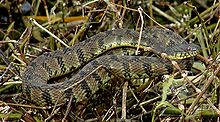- Nerodia rhombifer
-
Nerodia rhombifer 
Scientific classification Kingdom: Animalia Phylum: Chordata Class: Reptilia Order: Squamata Family: Colubridae Subfamily: Natricinae Genus: Nerodia Species: N. rhombifer Binomial name Nerodia rhombifer
(Hallowell, 1852)Subspecies N. r. blanchardi (Clay, 1938)
N. r. rhombifera (Hallowell, 1852)
N. r. werleri (Conant, 1953)Synonyms Tropidonotus rhombifera
Hallowell, 1852
Natrix rhombifera
Clay, 1938Nerodia rhombifer, commonly known as the diamondback water snake, is a species of water snake found throughout much of the central United States and northern Mexico. It is nonvenomous and a member of the colubrid family. There are three recognized subspecies of N. rhombifer. The species was first described as Tropidonotus rhombifera by Edward Hallowell in 1852.
Contents
Description
Diamondback water snakes are predominantly brown, dark brown, or dark olive green in color, with a black net-like pattern along their back, with each spot being vaguely diamond shaped. Dark vertical bars and lighter coloring are often present down the sides of the snake. The underside is generally a yellow or lighter brown color often with black blotching. Their scales are heavily keeled, giving the snake a rough texture. They can grow to a length of 1.5 m (4.9 ft) and in southern states have reached 2.5 m (8.2 ft) or more in length. Neonates are often lighter in color, making their pattern more pronounced, and they darken with age.
Behavior
The diamondback water snake is one of the most common species of snake within its range. It is found predominantly near slow moving bodies of water, streams, rivers, ponds, or swamps. Its primary diet is fish and amphibians, specifically slow fish, crayfish, amphiumas (eel-like salamanders), frogs and toads.[citation needed] When foraging for food they will hang on branches suspended over the water, dipping their head under, until they encounter a fish or other prey. They are frequently found basking on these branches over water, and when approached, they will quickly drop into the water and swim away. If cornered, they will often hiss, and flatten their head or body to appear larger. They only typically resort to biting if physically harassed or handled. Its bite is known to be quite painful due to its sharp teeth meant to keep hold of slippery fish. Unfortunately, this defensive behavior is frequently misinterpreted as aggression and often leads to them being mistaken for the venomous cottonmouth (Agkistrodon piscivorus), with whom they do share habitat in some places. The brown/tan coloration and diamond shaped pattern also causes these snakes to be mistaken for rattlesnakes, especially when encountered on land by individuals unfamiliar with snakes.
Geographic range
The diamondback water snake is found in the central United States, predominantly along the Mississippi River valley, but its range extends beyond that. It ranges within the states of Texas, Oklahoma, Kansas, Iowa, Louisiana, Arkansas, Missouri, Illinois, Indiana, Tennessee, Mississippi, Georgia, and Alabama. It is also found in northern Mexico, in the states of Coahuila, Nuevo León, Tamaulipas, and Veracruz.
Reproduction
Like other Nerodia species, diamondback water snakes are ovoviviparous. They breed in the spring and give birth in the late summer or early fall. Neonates are around 8–10 in (20–25 cm) in length. Though their range overlaps with several other species of water snake, interbreeding is not known.
Conservation concerns
While not endangered or threatened, their main threat is human ignorance. Diamondback water snakes are often mistaken for cottonmouths or rattlesnakes and are killed out of fear. In actuality, diamondback water snakes (and other species of water snake) are far more common than the venomous snakes in their range, especially in areas that are frequented by humans.
In captivity
Due to how common the species is, the diamondback water snake is frequently found in captivity, though there is little market value for it in the pet trade. Captive species will often bite when captured but become fairly docile with regular handling. They may also defecate when handled, which has a particularly offensive smell, probably due to their diet of mostly fish. They eat quite well in captivity if fed primarily fish but must be supplemented with vitamin B1. Larger specimens will often consume rodents.
References
- Species Nerodia rhombifer at The Reptile Database
- Herps of Texas: Nerodia rhombifer
- Illinois Natural History Survey: Nerodia rhombifer
- Snakes of Texas: Diamond-back Water Snake
- Diamondback Watersnake - Nerodia rhombifer Species account from the Iowa Reptile and Amphibian Field Guide
Categories:- Colubrids
- Animals described in 1852
- Reptiles of Mexico
- Reptiles of the United States
Wikimedia Foundation. 2010.

